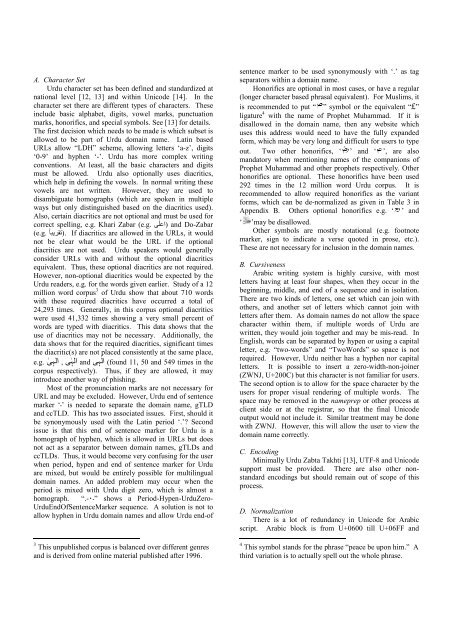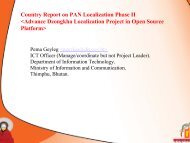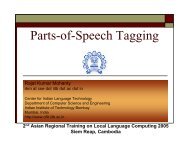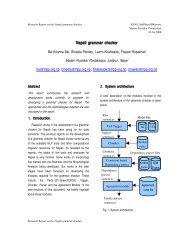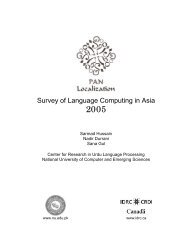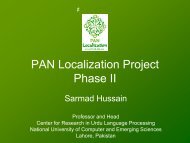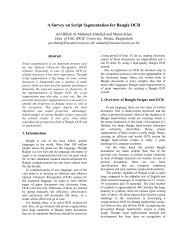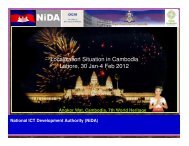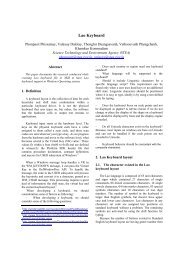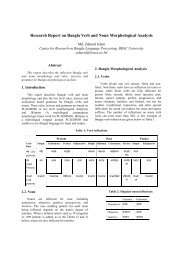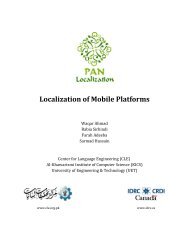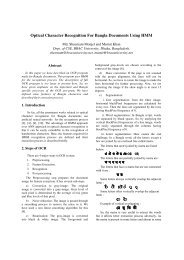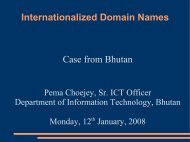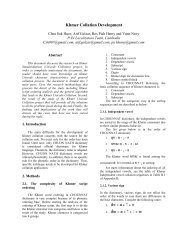Urdu Domain Names - PAN Localization
Urdu Domain Names - PAN Localization
Urdu Domain Names - PAN Localization
You also want an ePaper? Increase the reach of your titles
YUMPU automatically turns print PDFs into web optimized ePapers that Google loves.
ً<br />
ٰ<br />
ٰ<br />
A. Character Set<br />
<strong>Urdu</strong> character set has been defined and standardized at<br />
national level [12, 13] and within Unicode [14]. In the<br />
character set there are different types of characters. These<br />
include basic alphabet, digits, vowel marks, punctuation<br />
marks, honorifics, and special symbols. See [13] for details.<br />
The first decision which needs to be made is which subset is<br />
allowed to be part of <strong>Urdu</strong> domain name. Latin based<br />
URLs allow “LDH” scheme, allowing letters ‘a-z’, digits<br />
‘0-9’ and hyphen ‘-’. <strong>Urdu</strong> has more complex writing<br />
conventions. At least, all the basic characters and digits<br />
must be allowed. <strong>Urdu</strong> also optionally uses diacritics,<br />
which help in defining the vowels. In normal writing these<br />
vowels are not written. However, they are used to<br />
disambiguate homographs (which are spoken in multiple<br />
ways but only distinguished based on the diacritics used).<br />
Also, certain diacritics are not optional and must be used for<br />
correct spelling, e.g. Khari Zabar (e.g. (اعلی and Do-Zabar<br />
(e.g. .(تقريبا If diacritics are allowed in the URLs, it would<br />
not be clear what would be the URL if the optional<br />
diacritics are not used. <strong>Urdu</strong> speakers would generally<br />
consider URLs with and without the optional diacritics<br />
equivalent. Thus, these optional diacritics are not required.<br />
However, non-optional diacritics would be expected by the<br />
<strong>Urdu</strong> readers, e.g. for the words given earlier. Study of a 12<br />
million word corpus 3 of <strong>Urdu</strong> show that about 710 words<br />
with these required diacritics have occurred a total of<br />
24,293 times. Generally, in this corpus optional diacritics<br />
were used 41,332 times showing a very small percent of<br />
words are typed with diacritics. This data shows that the<br />
use of diacritics may not be necessary. Additionally, the<br />
data shows that for the required diacritics, significant times<br />
the diacritic(s) are not placed consistently at the same place,<br />
e.g. ٰی الہ and ی (found 11, 50 and 549 times in the<br />
corpus respectively). Thus, if they are allowed, it may<br />
introduce another way of phishing.<br />
Most of the pronunciation marks are not necessary for<br />
URL and may be excluded. However, <strong>Urdu</strong> end of sentence<br />
marker ’۔‘ is needed to separate the domain name, gTLD<br />
and ccTLD. This has two associated issues. First, should it<br />
be synonymously used with the Latin period ‘.’? Second<br />
issue is that this end of sentence marker for <strong>Urdu</strong> is a<br />
homograph of hyphen, which is allowed in URLs but does<br />
not act as a separator between domain names, gTLDs and<br />
ccTLDs. Thus, it would become very confusing for the user<br />
when period, hypen and end of sentence marker for <strong>Urdu</strong><br />
are mixed, but would be entirely possible for multilingual<br />
domain names. An added problem may occur when the<br />
period is mixed with <strong>Urdu</strong> digit zero, which is almost a<br />
homograph. “.- ٠ ”۔ shows a Period-Hypen-<strong>Urdu</strong>Zero-<br />
<strong>Urdu</strong>EndOfSentenceMarker sequence. A solution is not to<br />
allow hyphen in <strong>Urdu</strong> domain names and allow <strong>Urdu</strong> end-of<br />
الہ<br />
الہ , ٰی<br />
3 This unpublished corpus is balanced over different genres<br />
and is derived from online material published after 1996.<br />
sentence marker to be used synonymously with ‘.’ as tag<br />
separators within a domain name.<br />
Honorifics are optional in most cases, or have a regular<br />
(longer character based phrasal equivalent). For Muslims, it<br />
is recommended to put “ ” symbol or the equivalent “£”<br />
ligature 4 with the name of Prophet Muhammad. If it is<br />
disallowed in the domain name, then any website which<br />
uses this address would need to have the fully expanded<br />
form, which may be very long and difficult for users to type<br />
out. Two other honorifics, ‘ ’ and ‘ ’, are also<br />
mandatory when mentioning names of the companions of<br />
Prophet Muhammad and other prophets respectively. Other<br />
honorifics are optional. These honorifics have been used<br />
292 times in the 12 million word <strong>Urdu</strong> corpus. It is<br />
recommended to allow required honorifics as the variant<br />
forms, which can be de-normalized as given in Table 3 in<br />
Appendix B. Others optional honorifics e.g. ‘ ’ and<br />
‘ ’may be disallowed.<br />
Other symbols are mostly notational (e.g. footnote<br />
marker, sign to indicate a verse quoted in prose, etc.).<br />
These are not necessary for inclusion in the domain names.<br />
B. Cursiveness<br />
Arabic writing system is highly cursive, with most<br />
letters having at least four shapes, when they occur in the<br />
beginning, middle, and end of a sequence and in isolation.<br />
There are two kinds of letters, one set which can join with<br />
others, and another set of letters which cannot join with<br />
letters after them. As domain names do not allow the space<br />
character within them, if multiple words of <strong>Urdu</strong> are<br />
written, they would join together and may be mis-read. In<br />
English, words can be separated by hypen or using a capital<br />
letter, e.g. “two-words” and “TwoWords” so space is not<br />
required. However, <strong>Urdu</strong> neither has a hyphen nor capital<br />
letters. It is possible to insert a zero-width-non-joiner<br />
(ZWNJ, U+200C) but this character is not familiar for users.<br />
The second option is to allow for the space character by the<br />
users for proper visual rendering of multiple words. The<br />
space may be removed in the nameprep or other process at<br />
client side or at the registrar, so that the final Unicode<br />
output would not include it. Similar treatment may be done<br />
with ZWNJ. However, this will allow the user to view the<br />
domain name correctly.<br />
C. Encoding<br />
Minimally <strong>Urdu</strong> Zabta Takhti [13], UTF-8 and Unicode<br />
support must be provided. There are also other nonstandard<br />
encodings but should remain out of scope of this<br />
process.<br />
D. ormalization<br />
There is a lot of redundancy in Unicode for Arabic<br />
script. Arabic block is from U+0600 till U+06FF and<br />
4 This symbol stands for the phrase “peace be upon him.” A<br />
third variation is to actually spell out the whole phrase.


